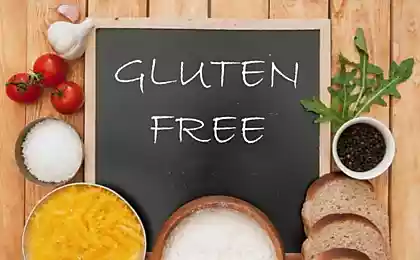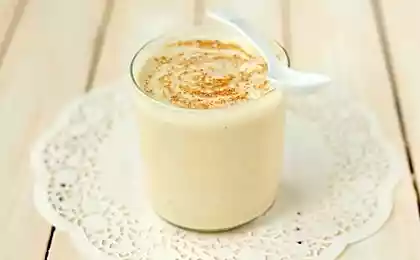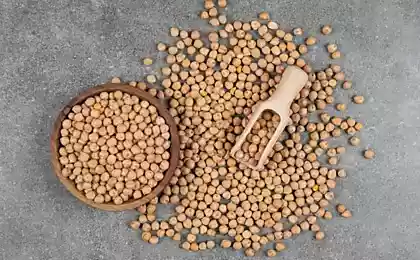598
Flour gluten free, healthy substitute for wheat flour
Pea flour has inherited the beneficial properties of pea, which is. Is a valuable dietary product and at the same time substitute for wheat flour for celiacs.
It is used for making casseroles, puddings, bakes bread and rolls, that taste in no way inferior to the traditional products made from wheat, but more useful and safe for the figure.
Nutritional value

The nutritional value of peas, respectively, and pea flour surpasses most of the vegetables. In its composition contains up to 6.7 % of vegetable protein and about 15 % carbohydrates, of which 6 % is sugar. The product record for the content of essential amino acids and proteins. Peas are also rich in nitrogenous compounds, vitamins C, B1, B2, B6, PP, D, E and K, potassium, calcium, phosphorus and sodium.
Protein component is similar to meat and dairy, so the pea and its derivatives are often compared to meat. The main differences between the vegetable version – no cholesterol and relatively low price.
Calorie pea flour: 71 kcal per 100 g of product.
What is the use?
Flour, which is derived from pea has a number of useful properties:
Is a natural source of such amino acids as threonine and lysine – they are vital for the functioning of our body.
The product contains pyridoxine which provides production and breakdown of amino acids. In the case of a deficiency of this substance in humans may cause seizures or the development of dermatitis.
Selenium, which in large quantities contained in the pea (the exact numbers depend on the growing region), has antioxidant properties and protects human cells from free radicals and carcinogens.
Vegetable protein in the product is much better absorbed, without straining thus gastro-intestinal tract and not providing the negative impact that can come from meat products.
The flour obtained from peas provides the body with energy, increases efficiency and endurance of the body.
With regular use , improves heart function, reduces the risk of hypertension, myocardial infarction, prevented the formation of blood clots in the blood vessels.
Recommended for people suffering from tuberculosis and diabetes.
Characterized by a delicate diuretic and choleretic effects.
Compounds included in the composition of the product, improve metabolism and prevent the deposition of subcutaneous fat. Regular use recommended for those who are overweight or just watching their figure.
To improve the functioning of the brain and "make-up" of nerve cells in people of mental labor before meals take 1 teaspoon of pea flour.
Due to the high fiber content helps to deal with constipation and other problems in the digestion or digestion.
Compresses with pea flour used in local healing of wounds and boils on the skin.
Can enter into a therapeutic meal plan with endocrine diseases.
Due to the high content of vitamins, baking with a flour will be useful for vitamin deficiency.
Successfully used in cosmetics. A beneficial effect both on the skin and hair.

The wonders of gluten-free
Because pea flour does not contain gluten, it can be used in the diet of people suffering from celiac disease – a disease associated with intolerance by the human body wheat protein (gluten in the composition of cereals).
Patients suffering from this (often hereditary) disease, not only has porridge and soups on the basis of the pea, and various pastries made with pea flour: bread, rolls, pies.
What's the harm?
Clear harm in the use of flour from peas within reasonable limits during medical research have been identified.
But there is a small list of contraindications:
1. The tendency to flatulence and fermentation processes in the intestine. To avoid this, it is recommended not to abuse the pea and its derivatives. During the cooking to them recommend adding fennel and dill (fresh, dried or in seed form) to reduce the gassing effect. Also do not drink dishes made from chickpea flour, cold water.
2. The presence of gout or other kidney diseases. This is due to the content in peas purines, which contribute to the accumulation of uric acid in the body. Patients with better to make use of such flour to a minimum so as not to aggravate the symptoms.
3. The aggravation of pancreatitis, gastritis or stomach ulcers. High amount of fiber provides an additional burden on the stomach, so in acute conditions of the digestive system from pea flour best avoided until complete recovery.
According to a study in 2013 in the "American journal of kidney diseases," the prevalence of protein in the diet may lead to impaired renal function even in healthy people. Therefore, experts advise to adhere to the balance and do not exceed the percentages of the proteins in the menu equal to 10-35 %.
How to cook at home?
Buy pea flour in almost every supermarket. But if you can't find her or doubt as store products, can do it yourself.
1. Choose a good dry peas, wash, if necessary, go through and be sure to dry. Do it better on paper or piece of cloth, put the peas in a single layer. The newspaper in this case can not be used because legumes are easy to absorb harmful substances from the printing ink.
2. For grinding of beans you can use a coffee grinder, mortar or grinder. The choice of device depends on what result you want to obtain. To obtain a gentle and soft first-class flour suitable electric coffee grinder. Manual coffee grinder or a meat grinder will give a more coarse grind. As for cooking the "old way", i.e. in a mortar, you will need a lot of strength and patience.
3. The resulting powder was put on a cloth of white fabric layer is not more than 2 cm, Leave in a dry place to dry. From time to time it is necessary to mix for uniform weathering of moisture. After drying, the pea flour will be a little lighter and will easily lag behind the hands.
Storage suitable paper bag or fabric pouch. The product of home cooking should be in a dry place. Before using pea flour, like any other, must be sifted.
Pea jelly

The most famous dishes of pea flour soups or mashed potatoes. But perhaps the most useful is the jelly.
Due to its shielding properties, a positive effect on the condition of the gastrointestinal tract, protecting the mucous membrane and improves digestion. This unusual drink is able to protect the gut from dysbiosis and rid your body of toxins and salts of lead.
Preparation:
1. Prepare the jelly as you would any other, but instead of using pea starch in the flour. For this it is slowly poured cold water and mix thoroughly to avoid lumps.
2. After the mixture put on fire and bring to a boil, stirring constantly so the flour does not stick to pans and not burnt.
3. At the stage of preparation of the drink, add salt and spices to taste.
4. When the mass thickens, the jelly is removed from the heat.
Feeding pea jelly in single-serve cups as a separate dish or, cut into small pieces, with fresh herbs, fried onions and mushrooms.
Of pea flour can make a huge number of tasty and healthy dishes. Including: soups, porridge, jelly, pies, pancakes, muffins, bread, pies, puddings, vegetarian burgers, vegetable noodles, and more. Choose!
P. S. And remember, only by changing their consumption — together we change the world! ©
Source: www.poleznenko.ru/gorohovaja-muka.html
It is used for making casseroles, puddings, bakes bread and rolls, that taste in no way inferior to the traditional products made from wheat, but more useful and safe for the figure.
Nutritional value

The nutritional value of peas, respectively, and pea flour surpasses most of the vegetables. In its composition contains up to 6.7 % of vegetable protein and about 15 % carbohydrates, of which 6 % is sugar. The product record for the content of essential amino acids and proteins. Peas are also rich in nitrogenous compounds, vitamins C, B1, B2, B6, PP, D, E and K, potassium, calcium, phosphorus and sodium.
Protein component is similar to meat and dairy, so the pea and its derivatives are often compared to meat. The main differences between the vegetable version – no cholesterol and relatively low price.
Calorie pea flour: 71 kcal per 100 g of product.
What is the use?
Flour, which is derived from pea has a number of useful properties:
Is a natural source of such amino acids as threonine and lysine – they are vital for the functioning of our body.
The product contains pyridoxine which provides production and breakdown of amino acids. In the case of a deficiency of this substance in humans may cause seizures or the development of dermatitis.
Selenium, which in large quantities contained in the pea (the exact numbers depend on the growing region), has antioxidant properties and protects human cells from free radicals and carcinogens.
Vegetable protein in the product is much better absorbed, without straining thus gastro-intestinal tract and not providing the negative impact that can come from meat products.
The flour obtained from peas provides the body with energy, increases efficiency and endurance of the body.
With regular use , improves heart function, reduces the risk of hypertension, myocardial infarction, prevented the formation of blood clots in the blood vessels.
Recommended for people suffering from tuberculosis and diabetes.
Characterized by a delicate diuretic and choleretic effects.
Compounds included in the composition of the product, improve metabolism and prevent the deposition of subcutaneous fat. Regular use recommended for those who are overweight or just watching their figure.
To improve the functioning of the brain and "make-up" of nerve cells in people of mental labor before meals take 1 teaspoon of pea flour.
Due to the high fiber content helps to deal with constipation and other problems in the digestion or digestion.
Compresses with pea flour used in local healing of wounds and boils on the skin.
Can enter into a therapeutic meal plan with endocrine diseases.
Due to the high content of vitamins, baking with a flour will be useful for vitamin deficiency.
Successfully used in cosmetics. A beneficial effect both on the skin and hair.

The wonders of gluten-free
Because pea flour does not contain gluten, it can be used in the diet of people suffering from celiac disease – a disease associated with intolerance by the human body wheat protein (gluten in the composition of cereals).
Patients suffering from this (often hereditary) disease, not only has porridge and soups on the basis of the pea, and various pastries made with pea flour: bread, rolls, pies.
What's the harm?
Clear harm in the use of flour from peas within reasonable limits during medical research have been identified.
But there is a small list of contraindications:
1. The tendency to flatulence and fermentation processes in the intestine. To avoid this, it is recommended not to abuse the pea and its derivatives. During the cooking to them recommend adding fennel and dill (fresh, dried or in seed form) to reduce the gassing effect. Also do not drink dishes made from chickpea flour, cold water.
2. The presence of gout or other kidney diseases. This is due to the content in peas purines, which contribute to the accumulation of uric acid in the body. Patients with better to make use of such flour to a minimum so as not to aggravate the symptoms.
3. The aggravation of pancreatitis, gastritis or stomach ulcers. High amount of fiber provides an additional burden on the stomach, so in acute conditions of the digestive system from pea flour best avoided until complete recovery.
According to a study in 2013 in the "American journal of kidney diseases," the prevalence of protein in the diet may lead to impaired renal function even in healthy people. Therefore, experts advise to adhere to the balance and do not exceed the percentages of the proteins in the menu equal to 10-35 %.
How to cook at home?
Buy pea flour in almost every supermarket. But if you can't find her or doubt as store products, can do it yourself.
1. Choose a good dry peas, wash, if necessary, go through and be sure to dry. Do it better on paper or piece of cloth, put the peas in a single layer. The newspaper in this case can not be used because legumes are easy to absorb harmful substances from the printing ink.
2. For grinding of beans you can use a coffee grinder, mortar or grinder. The choice of device depends on what result you want to obtain. To obtain a gentle and soft first-class flour suitable electric coffee grinder. Manual coffee grinder or a meat grinder will give a more coarse grind. As for cooking the "old way", i.e. in a mortar, you will need a lot of strength and patience.
3. The resulting powder was put on a cloth of white fabric layer is not more than 2 cm, Leave in a dry place to dry. From time to time it is necessary to mix for uniform weathering of moisture. After drying, the pea flour will be a little lighter and will easily lag behind the hands.
Storage suitable paper bag or fabric pouch. The product of home cooking should be in a dry place. Before using pea flour, like any other, must be sifted.
Pea jelly

The most famous dishes of pea flour soups or mashed potatoes. But perhaps the most useful is the jelly.
Due to its shielding properties, a positive effect on the condition of the gastrointestinal tract, protecting the mucous membrane and improves digestion. This unusual drink is able to protect the gut from dysbiosis and rid your body of toxins and salts of lead.
Preparation:
1. Prepare the jelly as you would any other, but instead of using pea starch in the flour. For this it is slowly poured cold water and mix thoroughly to avoid lumps.
2. After the mixture put on fire and bring to a boil, stirring constantly so the flour does not stick to pans and not burnt.
3. At the stage of preparation of the drink, add salt and spices to taste.
4. When the mass thickens, the jelly is removed from the heat.
Feeding pea jelly in single-serve cups as a separate dish or, cut into small pieces, with fresh herbs, fried onions and mushrooms.
Of pea flour can make a huge number of tasty and healthy dishes. Including: soups, porridge, jelly, pies, pancakes, muffins, bread, pies, puddings, vegetarian burgers, vegetable noodles, and more. Choose!
P. S. And remember, only by changing their consumption — together we change the world! ©
Source: www.poleznenko.ru/gorohovaja-muka.html























